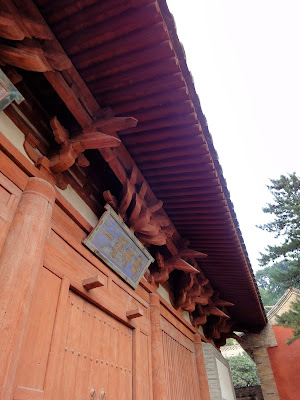Once upon a time, China was an empire of wooden structures. A trip to Shangxi Province made me extremely proud of my ancestors because of their superb techniques of engineering and construction.
One of the oldest preserved wooden structures is Foguang Temple, near Wutai. Its Great East Hall was constructed in 857 during the Tang Dynasty. (That was 1,153 years ago!) This is how it works structurally: the hipped roof frame sits on top of a series of columns with complex sets of brackets (called Dougong). The walls are not loading-bearing and there are large doors and windows. (Le Maison Domino??) The huge wooden bracket sets jump out four layers of arms, allowing the eaves to project almost 4 meters beyond the side of the walls. These brackets are fit together by joinery, without any glue or fasteners. Amazing precision and quality of carpentry!





The Manjusri Hall, another historic wooden structure in Foguang Temple, was constructed in 1137 during the Jin Dynasty. Without the "dropped ceiling" (Zaojing), we can see perfectly the structure of the roof frame.




100 kilometers away from Foguang Temple, stands the oldest wooden pergola in China - the Sakyamuni Pagoda of Fogong Temple in Ying County. It was built in 1056 during the Liao Dynasty. This 67-meter-tall fully wooden structure features 54 different types of Dougong, again, assembled with joinery, no glue or nails used. What a giant piece of 3D puzzle!







The most spectacular would be the Hanging Temple near Mount Heng. It was built 60 meters above the ground into a cliff. Seen from afar, it's like a relief carved on the surface of the mountain. Structurally, the buildings are supported on cantilevers. Horizontal holes were chiseled into the cliff, and square beams were inserted and wedged firmly in place. There are wimpy wooden poles under the buildings, but they were actually added after the buildings, more decorative (to make it look less scary) than structural.











No comments:
Post a Comment